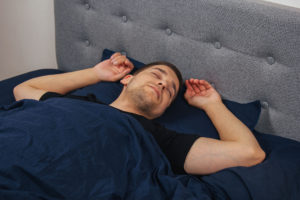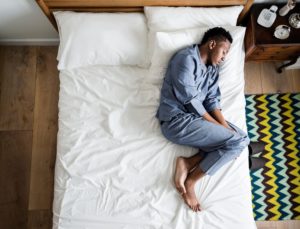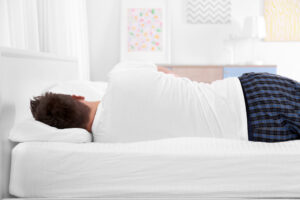Fetal Sleep Position
- The fetal sleeping position is one of the most common sleep positions.
- Many find the fetal position comfortable and that it can help alleviate snoring.
- This position may not be suitable for those with back pain, a shoulder injury, or people who are pregnant.
There is no one-size-fits-all approach when it comes to sleeping positions. Some people find sleeping on their backs to be the most comfortable, while others find stomach sleeping to be the best position for their bodies. Body positioning during sleep should be chosen based on what feels most comfortable to you.
Researchers often divide sleep positions into three categories: back, stomach, and side sleeping . Side sleeping is the most common, with sleepers spending 54% of each night on their sides, on average. Within each sleep position category, however, there are subtle variations. The fetal position, for example, is a specific form of side sleeping.
What Is the Fetal Sleep Position?

When you lie on your side and bring your knees up to your chest, you are sleeping in the fetal position. Some people curl an arm under their pillow to support their head while in this position, but others may not. It is called the fetal position because it mimics the position of a fetus in the womb.
Side sleeping is the most common sleep position, but researchers have not yet studied how many people curl up into the fetal position while sleeping on their sides. Sleeping on your side appears to become more preferable as you get older . Children usually spend equal time sleeping on their stomachs, sides, and backs, while older adults spend more time asleep on their sides.
Benefits of the Fetal Sleep Position
Sleeping on your side offers quite a few benefits. Studies show that sleeping on your side may help reduce heartburn , especially if you are sleeping on your left side. Snoring , another common sleep disturbance, is also reduced when sleeping on your side. You may want to consider sleeping in the fetal position if you share a bed with a partner, in order to minimize sleep disturbances and other issues caused by snoring.
Sleeping on your side might be a good option if you:
- Are pregnant
- Have heartburn or acid reflux
- Experience back pain
- Snore or have obstructive sleep apnea
- Are older or have limited spinal mobility

Who Should Sleep in the Fetal Position?
Some people may benefit more from side sleeping than others. Pregnant people, those who have obstructive sleep apnea, and people experiencing back pain may enjoy the greatest benefits from side sleeping.
Pregnant People
Sleeping in the fetal position may be a great option for people who are pregnant, especially in the later stages of pregnancy. Sleeping on your back while pregnant can put unnecessary pressure on your back and cardiac system.
The fetal position, in which you are sleeping on your side with your knees bent, can reduce pressure on your heart during pregnancy. Experts specifically recommend sleeping on your left side while pregnant.
Specialized pregnancy pillows can help support your back and legs during sleep so you can more comfortably sleep on your side. You can also use extra pillows you have around the house. Placing them under your belly and between your legs may help reduce any additional tension and promote spinal alignment as you side sleep.
People With Obstructive Sleep Apnea
Obstructive sleep apnea is a sleep disorder that affects 2% to 9% of adults. Sleep apnea occurs when your airway becomes partially or fully blocked during sleep, resulting in gasping or choking noises and snoring. Sleep apnea may cause daytime drowsiness and a lack of concentration, putting people who have the disorder at a higher risk for car crashes and other accidents.
Sleeping on your side can help reduce snoring and may help prevent the blockages to your airway associated with obstructive sleep apnea. Studies have found that people with sleep apnea who sleep on their sides are less likely to experience disruptive breathing during the night.
To help you sleep on your side throughout the night, you may want to try placing a pillow against your back to prevent you from rolling over.
People With Back Pain
Sleeping with back pain can be uncomfortable and discouraging. A reported 8 out of 10 people experience back pain at some point during their life. If you experience back pain, you might wonder if your sleeping position impacts how much pain you experience.
Sleeping on your side, which includes in the fetal position, has been shown to reduce back pain upon waking. When side sleeping, make sure your spine is aligned and there is no added pressure on your neck, which can cause neck pain. Sleeping with a pillow or rolled-up towel between your knees can help ensure that your spine is neutral and protected. You may also want to purchase a pillow specifically designed for side sleeping to protect your neck.
When to Consider Other Sleeping Positions
Sleeping in the fetal position may not be suitable for you if you have a shoulder injury or experience shoulder pain. Sleeping on your side can cause the shoulder to take on more pressure than usual. In a study of people who experience pain in only one shoulder, 67% were side sleepers who slept on the painful shoulder. This high percentage suggests side sleeping can cause or exacerbate shoulder pain in some people. If you prefer sleeping in the fetal position and experience shoulder pain, regularly alternating between sleeping on your left and right sides can help take the pressure off one shoulder.
If you are concerned about developing wrinkles, then sleeping on your side might not be the best option for you. The fetal position presses one side of your face against your pillow, and research suggests sleeping with your face against the pillow can cause wrinkling . Sleeping on your back may be preferable.

Still have questions? Ask our community!
Join our Sleep Care Community — a trusted hub of sleep health professionals, product specialists, and people just like you. Whether you need expert sleep advice for your insomnia or you’re searching for the perfect mattress, we’ve got you covered. Get personalized guidance from the experts who know sleep best.
References
15 Sources
-
Skarpsno, E. S., Mork, P. J., Nilsen, T., & Holtermann, A. (2017). Sleep positions and nocturnal body movements based on free-living accelerometer recordings: Association with demographics, lifestyle, and insomnia symptoms. Nature and Science of Sleep, 9, 267–275.
https://pubmed.ncbi.nlm.nih.gov/29138608/ -
De Koninck, J. Lorrain, D., & Gagnon, P. (1992). Sleep positions and position shifts in five age groups: An ontogenetic picture. Sleep, 15(2), 143–149.
https://pubmed.ncbi.nlm.nih.gov/1579788/ -
Khoury, R. M., Camacho-Lobato, L., Katz, P. O., Mohiuddin, M. A., & Castell, D. O. (1999). Influence of spontaneous sleep positions on nighttime recumbent reflux in patients with gastroesophageal reflux disease. The American journal of gastroenterology, 94(8), 2069–2073.
https://pubmed.ncbi.nlm.nih.gov/10445529/ -
Ravesloot, M. J., van Maanen, J. P., Dun, L., & de Vries, N. (2013). The undervalued potential of positional therapy in position-dependent snoring and obstructive sleep apnea: A review of the literature. Sleep & breathing, 17(1), 39–49.
https://pubmed.ncbi.nlm.nih.gov/22441662/ -
Troxel, W. M., Robles, T. F., Hall, M., & Buysse, D. J. (2007). Marital quality and the marital bed: Examining the covariation between relationship quality and sleep. Sleep Medicine Reviews, 11(5), 389–404.
https://pubmed.ncbi.nlm.nih.gov/17854738/ -
Rossi, A., Cornette, J., Johnson, M. R., Karamermer, Y., Springeling, T., Opic, P., Moelker, A., Krestin, G. P., Steegers, E., Roos-Hesselink, J., & van Geuns, R. J. (2011). Quantitative cardiovascular magnetic resonance in pregnant women: Cross-sectional analysis of physiological parameters throughout pregnancy and the impact of the supine position. Journal of Cardiovascular Magnetic Resonance: Official Journal of the Society for Cardiovascular Magnetic Resonance, 13(1), 31.
https://pubmed.ncbi.nlm.nih.gov/21708015/ -
A.D.A.M. Medical Encyclopedia. (2020, June 2). Problems sleeping during pregnancy. MedlinePlus., Retrieved June 6, 2021, from
https://medlineplus.gov/ency/patientinstructions/000559.htm -
Strohl, Kingman P. (2020, Sept). Obstructive Sleep Apnea. Merck Manual Professional Version., Retrieved June 6, 2021, from
https://www.msdmanuals.com/professional/pulmonary-disorders/sleep-apnea/obstructive-sleep-apnea -
MedlinePlus: National Library of Medicine (US). (2021, March 30). Sleep apnea., Retrieved June 6, 2021, from
https://medlineplus.gov/sleepapnea.html -
Nakano, H., Ikeda, T., Hayashi, M., Ohshima, E., & Onizuka, A. (2003). Effects of body position on snoring in apneic and nonapneic snorers. Sleep, 26(2), 169–172.
https://pubmed.ncbi.nlm.nih.gov/12683476/ -
Pinna, G. D., Robbi, E., La Rovere, M. T., Taurino, A. E., Bruschi, C., Guazzotti, G., & Maestri, R. (2015). Differential impact of body position on the severity of disordered breathing in heart failure patients with obstructive vs. central sleep apnoea. European Journal of Heart fFailure, 17(12), 1302–1309.
https://pubmed.ncbi.nlm.nih.gov/26467056/ -
MedlinePlus: National Library of Medicine (US). (2021, May 17). Back pain., Retrieved June 6, 2021, from
https://medlineplus.gov/backpain.html -
Cary, D., Briffa, K., & McKenna, L. (2019). Identifying relationships between sleep posture and non-specific spinal symptoms in adults: A scoping review. BMJ Open, 9(6), e027633.
https://pubmed.ncbi.nlm.nih.gov/31256029/ -
Kempf, B., & Kongsted, A. (2012). Association between the side of unilateral shoulder pain and preferred sleeping position: A cross-sectional study of 83 Danish patients. Journal of Manipulative and Physiological Therapeutics, 35(5), 407–412.
https://pubmed.ncbi.nlm.nih.gov/22608285/ -
Poljsak, B., Godic, A., Lampe, T., & Dahmane, R. (2012). The influence of the sleeping on the formation of facial wrinkles. Journal of Cosmetic and Laser Therapy: Official Publication of the European Society for Laser Dermatology, 14(3), 133–138.
https://pubmed.ncbi.nlm.nih.gov/22506801/















